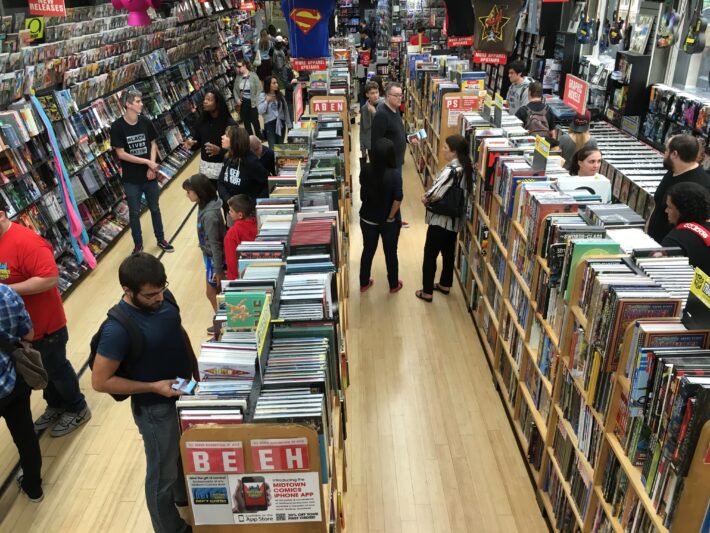
Based on last year’s record numbers, over 150,000 Comic Con attendees can be expected to descend on the Jacob Javits Convention Center on October 9th. Visitors will preview the newest Marvel and DC films; they will be exposed to heavy merchandising months ahead of release dates; and when they go home, they will pre-order the merchandise online.
Or they’ll walk into a store: The DC Collectibles’ statue of Harley Quinn, the character played by Margot Robbie in the film “Suicide Squad,” for example, is out of stock at every store in Manhattan. According to Midtown Comics shopkeeper Michael Wasilesky, she was pre-ordered in bulk months before the film’s release and disappeared from the shelves within weeks of the movie’s opening.
The 5,200 special-edition pieces sold out worldwide, but the store still takes online orders for a standard version. Her character is so popular that she attracted fans from all over the world to San Diego’s Comic Con two weeks before the film came out this past summer and has already spawned a newly-announced spinoff film. A sixth line of statues is available to pre-order for $249.99, up $100 from the first edition, for summer 2017.
Despite the popularity of online shopping, Midtown Comics shopkeeper Michael Wasilesky says that the store is “struggling” to keep up with in-person sales. In June, Comichron reporter Jackson Miller announced that retailers purchased the most comic books this year since Midtown Comics opened its first store nearly 20 years ago.
The collectibles manufacturer SIDESHOW, which exclusively sells online to both customers and wholesalers, couldn’t offer any sales numbers, but said that a strong core of consumers prefers to buy directly from the shelves. One such customer, Justin Eppers, browses the shelves at New York’s iconic Forbidden Planet, near Union Square. Eppers, a South Carolinian tourist who’d spent most of the previous day on a sight-seeing quest for the bronze Captain America statue in Prospect Park, says he considers comic book stores less bookstores than community centers.
“My friends don’t keep up to date with the stuff that I read, so I love going into my local comic book store to talk shop with the guy,” he says. “It’s less about the sales than a community.” Forbidden Planet, with its size and reputation, is a national “bastion” of that community.
Larger chains have not fared as well. Borders went bankrupt in 2011, FAO Schwarz and Toys R’ Us closed flagship stores in the past two years, and Barnes & Noble has been closing sites annually since 2000. Fortune recently reported that Barnes&Noble will only close eight stores this year, which is considered a victory.
Midtown Comics of Times Square, which opened in 1997, with a second location near Grand Central in 2004 and a third in the financial district in 2010, occupies 5,000 square feet on a street where a neighboring shopkeeper at Times Square Photo reports rent of around $40 per square foot. The commercial listings site thesquarefoot.com puts average neighborhood rents at $73. And according to owner Gerry Gladston, the business has yet-unannounced “plans for expansion.”
“Every single day we get tourists from France, Spain who see the films and the TV but they don’t have the stores,” says shopkeeper Wasilesky. Behind him, three Israeli French speakers peruse the action figures; David Cohen, in his thirties, says “it’s like a museum.”
“People will go through a stack of the same comic books to pick the perfect one,” says John Pacheco, a sales associate at Forbidden Planet. “They want it in better condition in hopes that they can resell it later or hoping that one day their collection will have more value than it does now.” An issue of Action Comics #1 sold in 2014 on ebay for $3.2 million– topping previous sales of the same issue for $1 million, due to the extraordinary whiteness of the paper. When the Margot Robbie Harley Quinn statue debuted, he said, customers were calling and visiting the store a half dozen times per week.
While customers are already speculating statues on the secondary market– Margot Robbie’s Harley Quinn has garnered bids in the $300 range on eBay– both Wasilesky and Pacheco said that the stores will not price-gouge. “We don’t want to do that to our customer, and we don’t need to do that, either,” says Wasilesky. “We know that people will keep coming to us because it’s at a lower price. We would rather sell to the everyday person.”